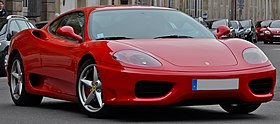Ferrari 360 Modena
| Ferrari 360 | |
|---|---|
 |
|
| Overview | |
| Manufacturer | Ferrari |
| Production | 1999–2005 |
| Assembly | Maranello, Italy |
| Designer | Pininfarina |
| Body and chassis | |
| Class | Sports car (S) |
| Body style | 2-door berlinetta 2-door spider |
| Layout | Longitudinal, Rear mid-engine, rear-wheel drive |
| Powertrain | |
| Engine | 3.6 L Tipo F131 V8 |
| Transmission | 6-speed manual 6-speed "F1" electrohydraulic manual |
| Dimensions | |
| Wheelbase | 2,600 mm (102 in) |
| Length | 4,477 mm (176 in) |
| Width | 1,922 mm (76 in) |
| Height | 1,214 mm (48 in) (Modena) 1,214 mm (48 in) (Spider) |
| Curb weight |
1,493 kg (3,291 lb) (Modena) |
| Chronology | |
| Predecessor | Ferrari F355 |
| Successor | Ferrari F430 |
1,493 kg (3,291 lb) (Modena)
1,553 kg (3,424 lb) (Spider)
The Ferrari 360 is a two-seater sports car built by Ferrari from 1999 to 2005. It succeeded the Ferrari F355 and was replaced by the Ferrari F430. It is a mid-engined, rear wheel drive V8-powered coupe.
Ferrari partnered with Alcoa to produce an entirely new all aluminium space-frame chassis that was 40% stiffer than the F355 which had utilized steel. The design was 28% lighter despite a 10% increase in overall dimensions. Along with a lightweight frame the new Pininfarina body styling deviated from traditions of the previous decade's sharp angles and flip-up headlights. The new V8 engine, common to all versions, utilizes a 3.6 litre capacity, flat plane crankshaft, titanium connecting rods and generates 395 bhp (294 kW, 400 PS). Despite what looks like on paper modest gains in reality the power to weight ratio was significantly improved on over the F355, this was due to the combination of both a lighter car and more power. According to Ferrari weight was reduced by 60 kg and the 0 to 100 km/h (62 mph) acceleration performance improved from 4.7 to 4.5 seconds. The 360 Modena press car was "ludicrously quick and sounded more like Schumacher's weekend wheels than a street car." But the other cars were different. When Car and Driver tested a F360 it proved heavier and slower than its predecessor five years before.
The first model to be rolled out was the 360 Modena followed later by the 360 Spider and finally as a special edition, the Challenge Stradale: which was the highest performance road-legal version of the 360 produced by the factory, featuring carbon ceramic brakes (from the Enzo), track tuned suspension, aerodynamic gains, weight reduction, power improvements and revised gearbox software among its track focused brief. There were 8,800 Modenas and 7,565 Spiders produced worldwide. There were 4,199 built for the US market, 1,810 (coupes) Modenas and 2,389 (convertibles) Spiders. Of those numbers there were only 469 Modenas and 670 Spiders that were produced with a gated 6 speed manual transmission as opposed to the automated F1 single clutch transmission.
In addition to this there were the low volume factory race cars, these were all derived from the 360 Modena and for the first time produced as a separate model in their own right (compared to being retro fit kit in previous incarnations). The first up was the 360 Modena Challenge, used in a one make series, the factory built racing cars were prepared by official tuner, Michelotto who also did the 360 N-GT. The N-GT was a 360 Challenge car evolved even further to compete more seriously in the FIA N-GT racing classes alongside other marques such as Porsche.
...
Wikipedia
